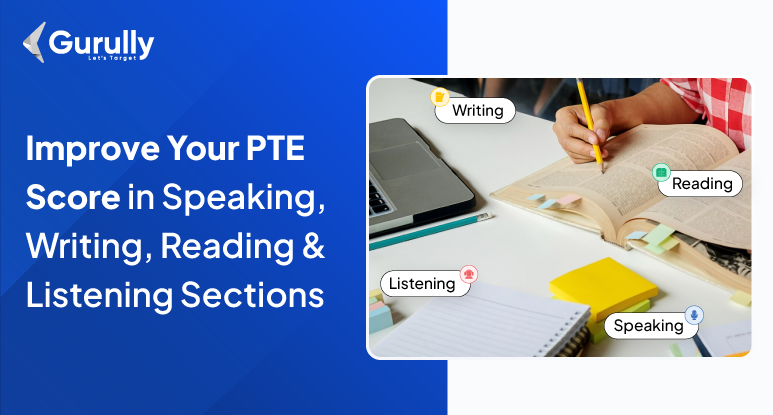Many universities and institutions worldwide accept PTE Exam scores, making it a popular choice for international students and migrants. However, achieving a high score requires targeted PTE preparation and a solid understanding of the different sections. This blog provides you with PTE tips and tricks to conquer each section – Reading, Writing, Speaking, and Listening – with effective strategies to maximize your score. Additionally, taking a free mock test is a vital step in preparing for the PTE exam, as it provides practice with real exam questions and helps build foundational skills.
Understanding the PTE Exam
before moving to TE tips and tricks understand the exam format. The PTE exam is a single, integrated test lasting approximately three hours. Each section focuses on a specific skill but may integrate other skills to assess your overall English proficiency. Here’s a quick breakdown:
- Speaking (45-50 minutes): Assesses your spoken English fluency, pronunciation, and ability to express yourself clearly in different situations.
- Writing (54-67 minutes): Evaluate your writing skills across various tasks, such as summarizing information, writing essays, and filling out forms.
- Reading (29-30 minutes): Tests your understanding of different types of written texts, including academic passages, emails, and online content.
- Listening (30-43 minutes): Measures your comprehension of spoken English through lectures, conversations, and academic talks.
Incorporating AI scoring into your PTE exam preparation can enhance assessment practices by providing accurate evaluations and personalized feedback, especially in the Reading and Speaking sections.
What is the PTE Exam?
The Pearson Test of English (PTE) is a computer-based English language proficiency test designed for non-native English speakers who want to study abroad or immigrate to English-speaking countries. The test assesses a candidate’s reading, writing, listening, and speaking skills in a single three-hour test session. The PTE exam is accepted by thousands of universities and colleges worldwide, including top institutions in the UK, Australia, New Zealand, and the US. This makes the PTE a highly recognized and valuable certification for anyone looking to advance their academic or professional career in an English-speaking environment.
Preparing for the PTE Exam
These PTE tips and tricks help students in forming a streamlined plan. Candidates should start by building a strong foundation in core English language skills, including reading, writing, listening, and speaking. Practice tests and mock tests are essential tools for PTE preparation, as they help candidates familiarize themselves with the test format, identify areas of improvement, and track their progress. With Gurully, candidates can access a wide range of practice tests and mock tests, including free mock tests, to help them prepare for the PTE exam. This comprehensive PTE Exam guide ensures that candidates are well-equipped to tackle each section of the test confidently.
Speaking Section:
Understand PTE tips and tricks for the speaking section and crack the toughest question type.
- Speak in English Daily: Consistent practice is your secret weapon. Immerse yourself in English daily to build fluency and confidence. Find a speaking partner, join online forums, or even have conversations with yourself.
- Self-Evaluate: Record yourself tackling various speaking tasks using a voice recorder or smartphone app. Listen back to your recordings—are there areas begging for improvement? This self-assessment will be your guide to targeted practice. To improve your speaking skills, you have to understand the logical and grammatical relationships within the text.
- Check Punctuations: Learn the art of correct pronunciation and intonation. Practice enunciating clearly and speaking with an understandable rhythm.
- Listen & Summarize: Improve your listening comprehension by immersing yourself in English audio—lectures, podcasts, and even news reports. Train yourself to summarize key points effectively, a skill crucial for retelling information tasks.
- Develop Image Description Skills: Practice describing various types of images in detail – sceneries, graphs, charts – the more diverse, the better.
Understand in detail PTE Exam Format 2024
Writing Section:
This writing section, PTE tips and tricks will solve all your queries and will make your exam journey easy.
- Write Clear & Simple: Keep your sentences short and easy to understand when writing your PTE essay. Avoid using complex words or phrases that might confuse the reader. The clearer your writing, the easier it is for the graders to understand your points.
- Organize Your Writing: Stay focused on the topic and present your ideas in a well-organized order. Start with a strong introduction that introduces your main point. Then, use clear paragraphs to develop your main points.
- Use Formal Language: Maintain a formal tone throughout your essay. Avoid using slang, abbreviations, or informal expressions.
- Build Strong Vocabulary: The wider your vocabulary, the better you can express yourself in your essay. Regularly read books, articles, or other materials in English to encounter new words. Actively try to understand their meaning and practice using them in your writing. Additionally, use prediction files to provide targeted practice questions and resources to enhance your preparation.
- Keep A Check On Grammar: Solid grammar is the foundation of clear and effective writing. Ensure you use correct grammar, sentence structures, and verb tenses throughout your essay. Proofread your work carefully.
- Keep Sentences in Flow: Transition words and phrases connect your ideas smoothly. These words help your essay flow naturally and guide the reader from one point to the next.
Reading Section:
- Understand the Question: This is the golden rule! Before diving into answer mode, take a moment to read the question carefully. Reread it if necessary. A clear understanding of the question is the foundation for a correct answer.
- Sharpen Your Skimming Skills: When you encounter a passage on a test, don’t get involved in every detail. Instead, develop the ability to quickly scan through the text to grasp the central idea and identify the main points.
- Focus On Keyword: Highlight key terms in the question: facts, figures, names, locations. These are your golden nuggets, guiding you towards the answer.
- Deep Dive Analysis: After understanding the overall meaning, do a close reading. Analyze the passage to find the answer that perfectly aligns with the question’s information.
- Eliminate the Confusion: Stuck on a multiple-choice question? Use the elimination strategy! Rule out options that seem irrelevant. This increases your chances of picking the right answer. Remember, it is essential for participants to select the best answer from the provided options.
- Time Management: Learn to manage your time effectively. Many students struggle to finish on time. Allocate more time to complex questions that demand more focus.
- Double-Check for Success: Always double-check your answers. This habit minimizes errors and prevents point deductions for silly mistakes.
Listening Section:
- Actively Listen: The first thing you need to do is listen actively. Start by watching movies without subtitles. This forces you to focus on the spoken words and develop your comprehension. You will need to pay close attention to different accents and speech patterns to improve your listening skills. Make note-taking a habit while listening to audio or watching videos. This strengthens your comprehension and prepares you for the task demands.
- Start Taking Notes: Since the PTE exam integrates listening with writing, practicing digital note-taking is crucial. Throughout your preparation, incorporate digital note-taking while listening to audio. This simulates the exam environment and hones your skills.
- Get Expertise In Managing Time: After selecting an answer, dedicate a few seconds to review. This allows you to catch any errors and make necessary corrections. During the allotted response time, divide your focus between listening to questions, understanding them, answering, and reviewing your answers.
- Focus on Details: Don’t underestimate the importance of details in the audio recordings. While keywords are crucial, focus on details like pronouns and tenses in the recording. These seemingly minor details can significantly impact your answer accuracy.
Effective PTE Tips and Tricks That You Can Use:
Effective test-taking strategies are crucial step of PTE Exam guide. Candidates should learn how to manage their time effectively, prioritize tasks, and stay focused throughout the test. Here are some effective test-taking strategies to help candidates achieve their target scores:
- Read the Instructions Carefully: Understanding the test format and instructions is the first step to success.
- Manage Your Time: Allocate sufficient time for each section, ensuring you can complete all tasks.
- Prioritize Tasks: Focus on the most challenging questions first and then move on to the easier ones.
- Use the Process of Elimination: Eliminate incorrect options to increase your chances of selecting the right answer.
- Practice with Sample Questions and Mock Tests: Build your endurance and confidence by practicing regularly.
Time Management and Test-Taking Strategies
Time management is critical in the PTE exam, as candidates have to complete each section within a limited time frame. Here are some time management and test-taking PTE tips and tricks to help candidates make the most of their time:
- Allocate Time Wisely: Based on the number of questions and the time available, allocate sufficient time for each section.
- Use a Timer: Keep track of the time and stay focused by using a timer during practice sessions.
- Prioritize Tasks: Focus on the most challenging questions first to ensure you have enough time to tackle them.
- Take Regular Breaks: Stay refreshed and focused by taking short breaks during your study sessions.
- Practice with Sample Questions and Mock Tests: Build your endurance and confidence by simulating the exam environment.
Common Mistakes to Avoid
Candidates should be aware of common mistakes to avoid in the PTE exam. Here are some common mistakes to avoid:
- Not Reading Instructions Carefully: Always read the instructions and understand the test format before starting.
- Poor Time Management: Failing to manage time effectively can lead to incomplete sections or unanswered questions.
- Ignoring Challenging Questions: Focus on the most challenging questions first to avoid wasting time and energy.
- Not Using the Process of Elimination: Eliminate incorrect options to improve your chances of selecting the right answer.
- Lack of Practice: Not practicing with sample questions and mock tests can lead to a lack of endurance and confidence.
By avoiding these common mistakes and using effective steps from PTE Exam guide, candidates can achieve their target scores and succeed in the PTE exam. With Gurully, candidates can access a wide range of practice tests and mock tests, including 1 free mock tests, to help them prepare for the PTE exam and achieve their goals.
Practice On Multiple PTE Exam Mock Tests
Mock tests mimic the actual exam environment, including question format, time constraints, and even the number of sections. Taking practice tests helps you get comfortable with the pressure and adjust your approach accordingly. Gurully’s PTE mock tests provide realistic exam simulations that help users become familiar with the PTE exam format.
Gurully’s online platform is your personal PTE Exam guide for success. We offer a complete suite of practice tools, including full-length mock tests with AI-powered scoring that mimics the real exam experience. This way, you’ll get a crystal-clear picture of your strengths, weaknesses, and how far you’ve come in your studies.
Following these strategies and practicing diligently can significantly improve your score and achieve the desired results. Remember, the key lies in understanding the question formats, managing your time effectively, and practicing with mock tests to simulate the real exam environment. Break a leg on your PTE exam.
📖 Useful Pages for PTE Test Takers
✅ PTE Academic Exam Pattern
✅ PTE Academic Fees & Registration
✅ PTE Academic Eligibility
✅ PTE Academic Result & Score
✅ PTE Academic Score Calculator







